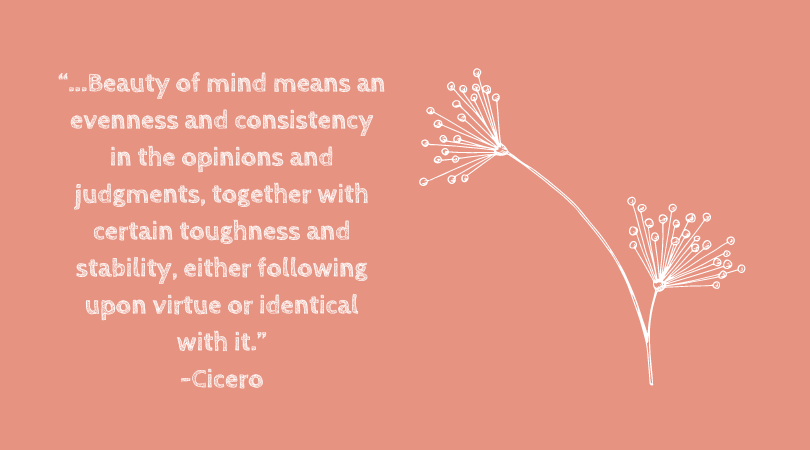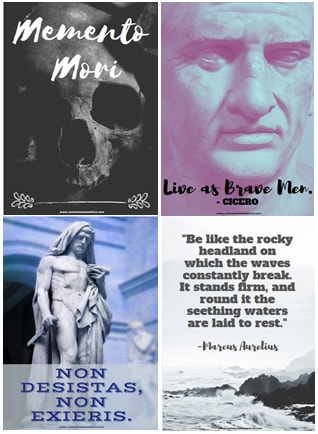The first part of the talk will be looking at what is moral beauty. We'll start with the ancient Stoics and we will fast forward about 1600 years to the Earl of Shaftesbury in England. Then we'll come up to contemporary times. How can we approach moral beauty? What does it mean for us today? And then the second segment of the talk will be some suggestions for how we can cultivate moral beauty today and make our lives more beautiful.
Ancient Stoics on Moral Beauty
We'll hear later on about how this idea applies to other external things. But for our purposes here, we are thinking about beauty as internal. So we have this big definition of beauty, but we can also apply it to the human character and say that this is an internal structure. And of course, we all know that the Stoics were really big on emphasizing consistency, internal harmony, constancy.
This is all structured by virtue. And it's functioning as the best of a human being when we show wisdom and justice towards others, for example. So I like this quote from Cicero. And by the way, I'm relying here on Aistė Čelkytė's book, The Stoic Theory of Beauty, which was introduced earlier today. But here is Cicero's quote:
When used of the body, the word beauty refers to a nice configuration of the limbs together with a pleasant coloring. Similarly, beauty of mind means an evenness and consistency in the opinions and judgments, together with certain toughness and stability, either following upon virtue or identical with it.
So this is very closely related to virtue. We have this bigger conception of what beauty is and specifically how it applies to our inner lives. And we also have a quote from Seneca, which illustrates this really well. This is from his Letters on Ethics. He says,
If we could examine the mind of a good man, oh, what a beautiful, what a sacred sight we would see, what grandeur, what calm would shine forth in it, and what constellations of the virtues, justice on one side, courage on the other, moderation and prudence over there. Besides these, frugality, self control, endurance, generosity, and cheerfulness would shed their light upon it, and human kindness, foresight too, and refinement, and most outstanding of all, greatness of spirit. What grace, and by God, what dignity would these bestow? How great its authority would be, and how much appreciated. Beloved it would be yet at the same time revered.
I love this because Seneca is, of course, describing virtue. These are things we would all recognize as pretty much a standard description of virtue, you know, wisdom, justice, temperance, moderation, the cardinal virtues, as well as some others like frugality, cheerfulness, endurance, which we would classify underneath the cardinal virtues.
But he couches it in aesthetic terms: grandeur and this idea of radiance, light. He uses several metaphors for light. So this kind of helps us to see virtue in a more concrete way. What does virtue actually look like? Virtue can be very abstract. This helps us to kind of visualize it and think about what would this actually mean in a person.
Shaftesbury on Moral Beauty
According to Shaftesbury, beauty and good are the same. He relied a lot on the idea of natural systems, the beauty of nature. So the idea that we heard earlier where the cosmos is a beautiful system and humans are beautiful when we fit into this system in appropriate ways. We don't think we're more important than we actually are or less important. We fit in appropriately. As Shaftesbury says:
to deserve the name of good or virtuous, a creature must have all his inclinations and affections, his dispositions of mind and temper, suitable and agreeing with the good of his kind, or of that system in which he is included, and of which he constitutes a part.
So again, this idea of fitting into our surroundings, our world, our cosmos, aligning ourselves with the bigger picture, not thinking that it's all about us. We're not the center of the world, and we're behaving in ways that are appropriate for what and who we are.
Humans are virtuous when we excel at doing what humans do best, which is being rational and sociable. So this idea of moral beauty is also internal harmony and consistency. We could describe this as integrity. And in fact, this is how Shaftesbury's intellectual biographer, Michael B. Gill describes it:
There are two aspects of the integrity that is moral beauty: within the virtuous person and between the virtuous person and the rest of humanity. And I would also add the rest of the world, the cosmos, all the parts of the morally beautiful person harmonize with each other. And the morally beautiful person harmonizes with everyone else.
In my own life, I tend to think of these as a vertical and a horizontal consistency or harmony. This is just the way I visualize it for myself. Vertical integration or vertical harmony means all of your desires, your thoughts, your beliefs, your opinions, your judgments (all of these things that Epictetus tells us are up to us) are all in alignment, all oriented in the same direction. And then your horizontal plane of harmony is your interactions and integration with the world, with society and the cosmos. So again, it's all about the, the structure that beauty can bring, that virtue can bring to us, to our inner character.
Why Frame Virtue in Terms of Beauty?
We all know beauty is attractive; it pulls us towards it. So when we talk about moral beauty, as virtue, we're propelled towards wanting to become virtuous or towards admiring it in someone else, like the hypothetical sage. We are really drawn toward it.
And I don't know about you, but for me as a practicing Stoic, it can sometimes be really difficult to stay oriented towards virtue, right? Sometimes it can seem like a slog or like a slap on the wrist. You know, it's all about self control or discipline or obligation, that kind of thing, whereas beauty really draws us toward it. It's our motivation. So thinking about virtue in terms of beauty can really motivate us to attain it.
Another reason for thinking about moral beauty is that it makes artistic appreciation a step toward virtue. Shaftesbury was living in a milieu, like many of us today, where people were not necessarily very interested in virtue, but they were interested in beautiful things. So he felt that this was a way he could really interest people who might not otherwise be interested in virtue. If he compared it to beauty or the beautiful things that they were used to, or aesthetic notions of artistry, it could really help people understand the point of virtue.
So maybe I appreciate beauty in this object, for example, or this painting, but it's just one step towards something that's even more important, grander, that will result in a truly good life. Of course, Shaftesbury did not conflate external beauty with internal beauty, you know, there's a clear distinction in Stoicism. But he saw it as a step in the right direction for people who might not otherwise ever think about philosophy or ever consider virtue. Beauty a way of drawing people's eye toward virtue, so to speak.
And another reason we might like to think about moral beauty is it enables us to become artists of our own lives. This is a really important metaphor that I will come back to at the end, but this was something Shaftesbury emphasized. He compared virtue to art, and of course the Stoics called our lives the art of living.
Virtue is the art of living. So Shaftesbury says, “is there not a workmanship and a truth in actions?” And he compared this to an artist creating a sculpture or a painting—again, to draw people from their existing knowledge of art towards something even greater, which would be virtue.
Moral Beauty Today
I'm going to share some psychology research with you. I always think it's interesting when contemporary psychology research corroborates what we've already discovered from philosophy or from practical Stoicism, applying this to our lives. I don't think that we actually need psychology to confirm philosophical principles in order to believe they are true or put them into practice. But I think it's always interesting when it does.
There's not a lot of research on moral beauty, but there is one strand. I will be talking today about the work of Rhett Diessner, who has done a lot of work in this area.
This particular study is a 2018 meta analysis. So they were looking at all of the psychology research that had been done up to that point about what we would call moral beauty, and they defined it quite similarly to the way we would: as virtue or unity in diversity, the harmonious coming together of many things in one.
This is one of their main findings from this study: appreciation of moral beauty is related to higher levels of pro-sociality and wellbeing. That sounds pretty good. Now here are some specifics. Moral beauty is related to:
- high agreeableness
- high levels of gratitude, forgiveness, connectedness to nature and loving all humanity
- prosocial values of benevolence, universalism, spirituality
- openness to experience, conscientiousness, self transcendence, satisfaction with life, hope, vitality, personal growth and purpose in life
- lower levels of neuroticism, envy and materialism
So if we had to put together some principles for moral beauty today, what would we say?
First, I would say virtue is beautiful for its structure, order, proportion, regularity, and harmony. These principles apply, as we've already seen, to nature, to art, and to humans.
Second, humans are beautiful when we fit well into the bigger system of the world or the cosmos. We correspond to ideal human nature, rationality and sociability, and we bring the mind into harmony with itself, which you might call integrity.
Third, when we see virtue as beautiful, we are strongly motivated to attain it. This is extremely important if we're pursuing virtue as part of a meaningful life, as part of a good life, as a lifelong pursuit. We need a treasure at the end of the path. We need to be motivated to continue this this difficult course.
Fourth, seeing ourselves as artists of our own lives enables us to beautify our character.
Cultivating Moral Beauty
1. Appreciate moral beauty in others
First of all, I think we can appreciate moral beauty in others. This is very important, even if you don't live with a sage, right? Even if the people around you are not perfect, you can still identify and appreciate the areas where they do shine.
Marcus Aurelius really points the way on this. He says:
When you want to gladden your heart, think of the good qualities of those around you. The energy of one, for instance, the modesty of another, the generosity of a third, and some other quality in another, for there is nothing more heartening than the images of the virtues shining forth in the characters of those around us, and assembled together in close array, so be sure to keep them ever at hand.
Now, Marcus Aurelius didn't think that everyone around him was perfect, as we can see from his other meditations, but he found a way to appreciate the beauty that did exist in the people around him. We can also see this extensively in Book One, where he made a long list of the virtues of the people he had known throughout his life.
2. Learn to see beauty all around you
Now, we've talked a lot today about beautiful objects, which we know to be indifferent. Beautiful artwork, beautiful homes, this kind of thing. These are indifferents. They are not necessary for a good life. That type of beauty is external to us. But we can still learn to appreciate beauty around us, even in places where others might not see it.
Here is another really insightful idea from Marcus Aurelius. He says:
If a person is endowed with sensibility and has a deep enough insight into the workings of the universe, you will find scarcely anything, which fails to please him in some way by its presence. Such a person will view the gaping jaws of wild beasts with no less pleasure than the portrayals of them displayed by painters and sculptors.
And he'll be able to see in an old woman or old man, a special kind of mature beauty. And he lists a number of things like baking bread, ears of corn bending toward the earth. even foam dripping from the jaws of a wild boar, which most other people would not really consider beautiful, but because they are part of nature, we can see them as beautiful.
I think this is especially important at times when we may not readily see beauty around us. Even in times of difficulty, the stoic sage—sitting in a jail cell, for example—would still be able to detect beauty around her. So we can learn to see beauty even where others wouldn't and become happier and appreciate the world around us in this way.
3. Sculpt your own character
And finally, we can learn to sculpt our own characters, just like Shaftesbury recommended, and of course like Epictetus recommended. Epictetus says:
Just as wood is the material of the carpenter and bronze that of the sculptor, the art of living has each individual's own life as its material.
I absolutely love this metaphor because it puts the power back in our hands to do something about our own lives. If we see beauty as something that's unattainable, we feel like we can't reach it. That's no good. So this perspective gives control back to us.
Shaftesbury also adds:
the wise and able man, who with a slight regard to outward things, applies himself to cultivate another soil, builds in a different matter from that of stone or marble and becomes, in truth, the architect of his own life and fortune by laying within himself the lasting and sure foundations of order, peace, ability, and concord.
So again, it's up to us to create these things in ourselves, to create our own inner beauty and keep sculpting our statue.
~
Read Next:
Wise Advice on Human Flourishing in 10 Terrific Quotes
5 Insightful Ways to Identify and Change Your Character Flaws
Beauty in Philosophy, Ethics and Art: A Conversation with David Fideler










